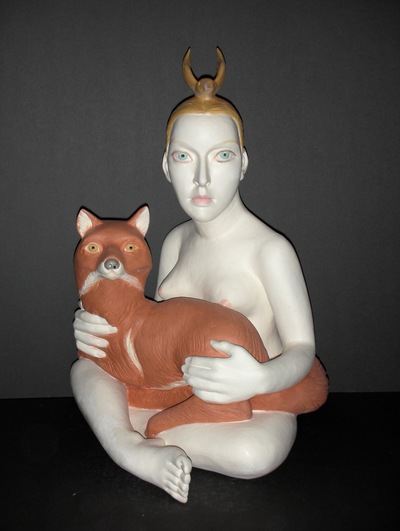GEORGE WALKER - 80TH BIRTHDAY RETROSPRECTIVE EXHIBITION

About the exhibition
The work of George Walker, one of Britain's most important ceramic sculptors, is instantly recognizable, yet he has always had an 'outsider' status, working without reference to ideas and trends within the art world. The themes with which his work deals include gender, authoritarian institutions and global geopolitics. His work is held in several private and public collections in England, Europe and especially the USA and has been featured in many publications.
George Walker’s work is a sophisticated commentary on interpersonal relationships in western culture, and on geopolitical and economic realities. Having studied painting originally, he turned to ceramics later in life. He found this a more satisfying medium than a flat surface for depicting the relationships and drama he wanted to express. His work continues in three dimensional format the type of social commentary more familiar from the traditions of political sculpture and caricaturist drawings of, for example, George Grosz, James Gillray and Thomas Nast. The sculptures are frequently unsettling, confronting the viewer with insights into aspects of our lives or of our world that we take for granted.
Walker’s work is also concerned with the history of sculpture in Western art both in terms of color and form. Color is an integral part of his work for its decorative effect but also to enhance narrative clarity. He is dismissive of the way art critics and fashions have rewritten the rules of what is acceptable in sculpture, a belief he sees as being founded upon the fact that ancient polychrome sculptures have survived down the ages without their original colours and often as broken torsos without arms and legs. He argues that the limbless female torso then became an accepted depiction of the female form in western sculptural traditions largely through the work of artists like Rodin and Maillol. He has made a series of works re-uniting these torsos with their limbs.
All George Walker’s sculptures are handbuilt, using traditional clay techniques of coiling, pinching and slab building. After initial biscuit firing, they are fired up to three additional times with vitreous slips. Walker does not see himself as a ceramicist, and he has never been interested in the technical details, such as glaze making, which usually occupy potters. He works in clay as this has the plasticity he needs for creating the complicated forms he wants to create. He breaks the rules of true ceramicists by sometimes adding small touches of all paint to the fired pieces if he wants to include a detail of colour that cannot be achieved with slips.
With an ironic nod to the ceramic material with which he works, many of the sculptures are in the notional form of teapots or other vessels. The head of a figure may form a removable lid, an arched body the handle, and apertures in a mouth, shoe or gun barrel for example, may form a spout. Since for much of his life Walker has been fairly reclusive and not engaged with the world of ceramics and pottery, it was not until very recently that he became aware of the tradition of novelty teapots or even of teapot collectors. His own stylized teapots developed out of a totally different trajectory.
The sculptures always begin as sketches which attempt to depict the power relationship between the protagonists of the story underlying the piece. They finally end up as drawings of increasing definition, often being squared up and with desired colours notated. The challenge is then to translate this two dimensional image into three dimensional form, building the clay up from the base as if it was to be a pot.
Very rarely for an artist working in any medium or art form, George Walker seldom repeats the same shape, so almost every sculpture is totally unique. However what remains constant in all his work are the underlying themes and recurring iconography. The main themes concern the conflict between the male and female parts of the psyche and what he believes is the lack of true free will. This is because all individuals are from birth already constrained in how they can think by the dominating cultural ideas they are born into. To name just a few of the recurring imagery and iconography are characters with their eyes blindfolded (by hands, books, scarves etc); mothers not holding babies properly; parental figures sitting on top of character’s heads; cockerels; bandages. Many of these are self explanatory ideas, and others refer to real episodes in Walker’s childhood. Chief amongst these is the cockerel which he had as a childhood pet while growing up in London at the end of WWII, which would fly up and sit on his head or shoulder.
Featured work

George Walker
Bernay's Burger

George Walker
Bernay's Burger (detail)

George Walker
The Protector

George Walker
The Protector (detail)

George Walker
Sentient Beings

George Walker
Sentient Beings (detail)

George Walker
The Bull